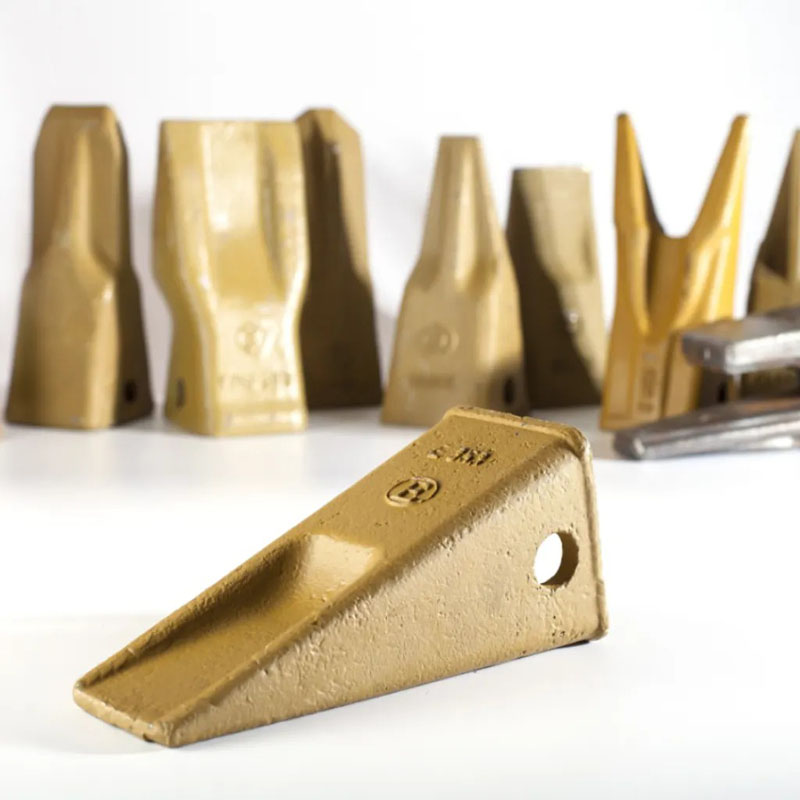Why Are Bucket Teeth Essential for Excavator and Loader Performance?
2025-09-11
In heavy machinery operations, bucket teeth are among the most critical wear components. They serve as the contact point between the ground and the machine, directly influencing digging efficiency, fuel consumption, and equipment lifespan. Whether used on excavators, loaders, or backhoes, bucket teeth play a decisive role in productivity and operational costs.
Bucket teeth are designed to penetrate soil, gravel, rock, or demolition debris. Without them, buckets would wear out quickly, and machines would lose their digging edge. High-quality bucket teeth ensure consistent penetration, reduced resistance, and optimized energy transfer from the hydraulic system to the ground.
Why Bucket Teeth Are Crucial:
-
Improved Penetration: Sharper teeth reduce resistance, making digging faster.
-
Extended Machine Life: They protect the bucket from direct abrasion and impact.
-
Lower Fuel Consumption: Less resistance means the engine uses less power.
-
Versatility: Different types of teeth fit various ground conditions, from soft soil to hard rock.
By investing in the right bucket teeth, contractors minimize downtime and maximize return on investment.
How to Choose the Right Bucket Teeth for Your Equipment
Selecting the right bucket teeth is not a one-size-fits-all decision. The choice depends on ground conditions, machine type, and jobsite requirements. Choosing poorly matched bucket teeth can lead to accelerated wear, machine strain, and unnecessary expenses.
Key Factors to Consider:
-
Soil Condition:
-
Soft soil → Standard chisel teeth
-
Compact soil → Tiger teeth or twin tiger teeth
-
Rocky terrain → Rock penetration teeth
-
Demolition & quarrying → Heavy-duty teeth with reinforced design
-
-
Machine Type:
-
Excavators require teeth with deeper penetration and durability.
-
Loaders benefit from teeth that balance penetration with material retention.
-
-
Tooth System Compatibility:
Ensure that the chosen teeth fit the adapter and locking system of your machine. Misaligned or incompatible teeth lead to premature breakage.
Professional Parameters of Our Bucket Teeth:
| Parameter | Specification Details |
|---|---|
| Material | High-strength alloy steel with heat treatment |
| Hardness | 48–52 HRC for balance of toughness and wear resistance |
| Impact Resistance | Engineered to absorb high-impact forces |
| Surface Finish | Precision casting with anti-corrosion coating |
| Compatibility | Fits major brands: Caterpillar, Komatsu, Hitachi, Volvo |
| Service Life | 20–30% longer than standard market alternatives |
When contractors align their bucket teeth selection with these parameters, machines perform at optimal efficiency, lowering operational costs over time.
What Are the Different Types of Bucket Teeth and Their Applications?
Bucket teeth come in multiple shapes and structures, each designed for a specific application. Knowing the right type ensures maximum productivity and machine safety.
Common Types of Bucket Teeth:
-
Chisel Teeth: Ideal for general-purpose digging in soil, clay, or sand.
-
Tiger Teeth: Designed with a pointed profile for tough penetration in compact or frozen ground.
-
Twin Tiger Teeth: Provide dual points for faster penetration in extremely compact terrain.
-
Rock Teeth: Reinforced design for quarrying, mining, and high-impact rock operations.
-
Heavy-Duty Teeth: Extra wear material for demolition and abrasive conditions.
Practical Example:
A contractor digging trenches in sandy soil benefits most from chisel teeth for smooth penetration, while a mining operator in hard granite terrain relies on heavy-duty rock teeth to withstand constant impact.
Benefits of the Right Match:
-
Reduced wear on the bucket and adapters
-
Faster cycle times per excavation
-
Increased fuel efficiency
-
Lower machine maintenance costs
Investing in the correct bucket teeth type directly translates into better jobsite results.
Why Long-Term Value Depends on Quality Bucket Teeth
The cost of bucket teeth is small compared to the overall expense of machine downtime, repairs, and lost productivity. High-quality teeth, engineered with advanced metallurgy and heat treatment, not only last longer but also protect the entire bucket system.
Advantages of Premium Bucket Teeth:
-
Durability: Withstand abrasive conditions and high-impact stress.
-
Safety: Secure locking systems prevent tooth loss during operation.
-
Productivity: Keep machines working at peak performance longer.
-
Cost Savings: Reduce downtime caused by frequent replacements.
Common Questions About Bucket Teeth
Q1: How often should bucket teeth be replaced?
A1: Replacement intervals depend on soil conditions and usage intensity. On average, contractors replace teeth every 400–800 operating hours. However, in abrasive rock or demolition projects, replacement may be required sooner. Regular inspection for rounding, cracks, or thinning ensures timely replacement.
Q2: Can different bucket teeth types be mixed on one bucket?
A2: While technically possible, it is not recommended. Mixing teeth leads to uneven penetration, higher stress on the bucket, and faster wear. For best results, all teeth should be uniform in type and wear level.
The Long-Term Impact of Choosing the Right Bucket Teeth
Bucket teeth may be small in size, but their impact on machine efficiency and project profitability is enormous. By understanding what they are, how to choose them, and why different types exist, contractors ensure better performance, longer machine life, and reduced operating costs.
At Lano, we provide high-strength, precision-engineered bucket teeth designed to fit major machine brands and withstand the toughest jobsite conditions. Our products combine durability, efficiency, and cost-effectiveness to help contractors achieve maximum productivity.
For detailed specifications, customized recommendations, or wholesale inquiries, contact us today to learn how Lano bucket teeth can elevate your excavation and loading operations.
